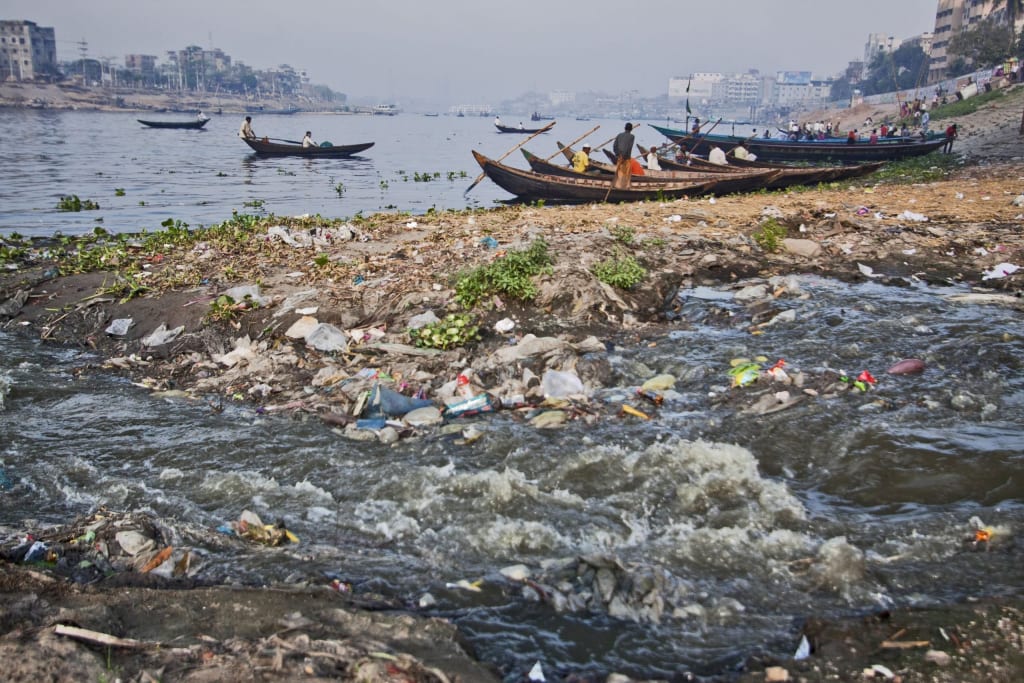When the River Cried
Pristine river and the efforts of a local community to restore it to its former glory.

Once upon a time, in a quiet corner of the world, there flowed a river of unparalleled beauty. It meandered gracefully through lush green landscapes, nourishing the earth and giving life to all it touched. People traveled from far and wide to witness its crystal-clear waters and bask in the serenity it offered.
Generations of families had grown up along its banks, their livelihoods intricately woven into the river's existence. Children played by its shores, fishermen cast their nets, and lovers whispered sweet nothings under the shade of ancient trees. The river was not just a waterway; it was the heart of the community, a source of life and joy.
But as the years passed, the world around the river changed. Industries began to spring up, and urbanization encroached upon the once-pristine landscapes. With progress came pollution, and soon, the river's once-crystal waters turned murky and lifeless.
The river began to cry. Its lament could be heard in the mournful winds that rustled through the trees, in the mournful songs of the birds that had once thrived along its banks. Its tears were made of oil spills, chemical discharges, and discarded waste that choked its very essence.
The community that had thrived for generations now faced a dire choice: to let their beloved river die a slow, agonizing death or to take action and bring it back to life. They chose the latter.
With heavy hearts and determined spirits, they rallied together. Community leaders, environmentalists, and concerned citizens formed a united front. They organized clean-up efforts that spanned months, fishing out tires, plastics, and toxic waste from the river's depths.
Schoolchildren were educated about the river's importance and the impact of pollution. They painted murals along its banks, reminding everyone of its former beauty and the hope of restoration. Artists and musicians came to share their talents, their art reflecting the river's cry for help.
Government agencies and local businesses were engaged in the cause, with regulations put in place to control pollution and promote responsible waste disposal. Watershed protection zones were established, and sustainable farming practices were encouraged.
Slowly but steadily, the river began to respond to the community's love and care. The once-murky waters began to clear, and fish returned to its depths. Birds once again sang their joyful songs along its banks.
As seasons passed, the river regained its vitality. The tears of pollution were replaced with tears of joy, as the community witnessed the resurrection of their beloved waterway.
"When the River Cried" became a story of resilience, determination, and the enduring bond between humans and nature. The community's efforts were a testament to the power of collective action and the ability to heal wounds inflicted on the environment.
The river, once on the brink of death, now flowed with newfound life, a living testament to the strength of a community's love and commitment to restoring the beauty that had been lost.
In the story of "When the River Cried," we witnessed a once-pristine river named Seraphine fall victim to pollution, degradation, and neglect. The local community, driven by their love for the river, took it upon themselves to initiate the restoration process. However, this tale also emphasizes the crucial role of government responsibility in addressing the broader issue of environmental degradation and climate change.
Governments, at various levels, hold a significant responsibility when it comes to climate change for several reasons:
1. Policy Development: Governments are responsible for crafting policies and regulations that govern industrial practices, emissions standards, waste disposal, and environmental protection. These policies play a pivotal role in preventing environmental degradation and promoting sustainability.
2. Enforcement: It is the government's duty to enforce environmental laws and regulations. Effective enforcement ensures that businesses and individuals comply with environmental standards and do not engage in activities that harm the environment.
3. Investment in Sustainability: Governments can allocate resources and funding for research, development, and implementation of sustainable technologies and practices. This includes investments in renewable energy, eco-friendly transportation, and climate-resilient infrastructure.
4. International Cooperation: Climate change is a global issue, and governments participate in international agreements and collaborations aimed at mitigating its effects. Initiatives like the Paris Agreement involve governments pledging to reduce greenhouse gas emissions and combat global warming collectively.
5. Education and Awareness: Governments can play a pivotal role in educating the public about climate change and fostering a culture of environmental responsibility. This can be achieved through public awareness campaigns, school curriculum enhancements, and community engagement.
6. Adaptation and Resilience: Governments must also prepare communities for the impacts of climate change. This involves planning for extreme weather events, rising sea levels, and other consequences, ensuring that infrastructure and emergency response systems are resilient.
7. Economic Incentives: Governments can implement incentives such as tax breaks, subsidies, and carbon pricing to encourage businesses and individuals to adopt eco-friendly practices and reduce emissions.
8. Long-Term Planning: Climate change is a long-term challenge, and governments must engage in strategic planning to address its effects over time. This includes setting emissions reduction targets, defining adaptation strategies, and monitoring progress.
About the Creator
Enjoyed the story? Support the Creator.
Subscribe for free to receive all their stories in your feed. You could also pledge your support or give them a one-off tip, letting them know you appreciate their work.





Comments
There are no comments for this story
Be the first to respond and start the conversation.